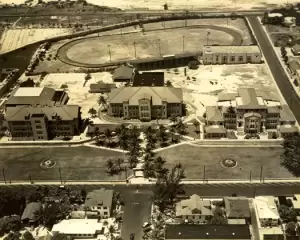Central Schools

When West Palm Beach built its new Central School in 1908, residents had wondered if the town would ever grow into it. The school on “The Hill” held grades K-12 until 1915, when it became Central Elementary, and Palm Beach High School was added to the south. Students from Delray Beach to Jupiter traveled by boat to West Palm Beach to attend its schools on the hill. As there was no heating system, the schools closed a few days a year during cold weather.
In 1922 the second building became Central Junior High School when a larger Palm Beach High School was added to the south of it. According to former student Gordon Williams, the cornerstone of the third building contained the signatures of all the students present on the day it was put in place. Today the buildings are part of the Alexander W. Dreyfoos Jr. School of the Arts.
The student body outgrew the auditorium in the center building by the mid-1920s; in 1927 the graduation program for 101 seniors took place at the Methodist Church on Hibiscus Street. In addition to year-round residents, some students attended in the winter while their parents found seasonal work. The City of West Palm Beach provided running water and outhouses at a campground south of Okeechobee Boulevard near the Seaboard railroad tracks.
Guy Metcalf
Guy Metcalf, who had led the push for better schools centered in West Palm Beach, became superintendent of Palm Beach County schools in 1917; a year later he was suspended for forgery. Metcalf told a friend he had no recollection of committing the crime; the next morning he was found dead in his office at the 1916 County Courthouse, having shot himself.
Former county judge Emery Newell lived in Lake Park and attended Palm Beach High School from 1939 to 1945 as he recounted in a 2004 oral history interview:
[It] was the only high school, unless you went to Lake Worth. Jupiter from time to time had a high school. It would kind of depend on how many children lived in Jupiter. When they got a half dozen, they’d start up a high school, and then next year there would only be two or three. … Those were the days when schools were segregated, and every single white child north of 59th Street in West Palm Beach rode one bus to Palm Beach High School.
Emery Newell
Football
Palm Beach and Lake Worth had the area’s first high school football teams. Monroe Farber, perhaps the last Palm Beach player from the inaugural football decade of the 1920s, died in 2007, as did two players from the 1930s. Billy Burns was said to be the only student to earn four athletics letters in four years, and Jack Boise led the University of Tennessee to a 17-0 win against Oklahoma in the 1939 Orange Bowl.

